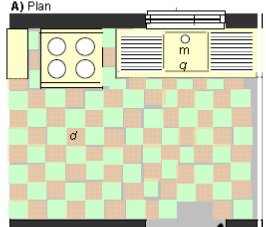


HHSRS VERSION 2
SEPTEMBER 2004
DOMESTIC HYGIENE (PESTS)
HHSRS VERSION 2
Vulnerable age
Related hazards
A) Kitchen floor
All ages
Falls on level, Damp
Multiple locations
Yes
No
Secondary hazards
Yes
No
Front elevation
A) Plan
DESCRIPTION OF HAZARD/S
Dwelling:
Early 1960's, semi-detached non-trad house
A) Kitchen floor: The main photograph shows the kitchen floor looking through an internal door.
Throughout the kitchen, the original thermoplastic plastic tiles have become unstuck due to rising
damp through the concrete sub-floor and have also become brittle and broken with age. The
remaining floors in the dwelling, although similarly damp on the ground floor, do not present any
additional risk. In addition (although not shown in the photgraphs) there are unsealed joints around
the service entry points, and, because of the form of construction, potential harbourage within the
wall structure, although no current infestation.
A
n
Water seals
-
o
Disrepair to drains
-
p
Open vent pipes
-
q
Design deficiencies
3
r
Internal refuse areas
-
s
External refuse areas
-
t
refuse chutes
-
# Secondary hazards
None
-
Key
3
Seriously defective
1 Not satisfactory
2
Defective
- Satisfactory/NA
LIST OF RELEVANT MATTERS
LIKELIHOOD & OUTCOMES
A
a
Internal walls and ceilings
-
b
External walls and roof
-
c
Ventilators
-
d
Solid floors
3
e
Suspended floors
-
f
Under floor space
-
g
Roof space
-
h
Skirting and architraves
-
I
Windows and doors
-
j
Window and door frames
-
k
Ducts and pipework
-
l
Access to ducts
-
m Service entry points
3
Improved
A B C D E F G H
I
Av: <1
J
Average likelihood, outcomes and HHSRS score for hazards associated with domestic
hygiene, pests etc for all persons in all dwellings, 1995-96
Score
24
HHSRS VERSION 2
SEPTEMBER 2004
HEALTH AND SAFETY RATING SYSTEM SCORES
1946-79 House
LIKELIHOOD
1 in
1
Low
High
Average: 5,585
Example
1
< 4200 2400 1300 750 420 240 130
75
42
24
13
7.5
4
2.5
1.5 >
Justification
OUTCOMES
Class I
Class II
Class III
Class IV
Justification
RATING
The extent of the hazard fault and its location increases the likelihood of a major
occurrence significantly above that for the average for this hazard. The possibility of the
spillage of food and the dampness, together with the difficulties of cleaning, increase the
likelihood of the harborage of insects, cockroaches etc, and the risk of infection,
particularly to young children. The joints around service entry points will allow access for
pests, and the wall structure will also provide harbourage.
%
Average: 0.0
0.0
< 0.05 0.15 0.3
0.7
1.5
3
7
15
26
38 >
Av: 0.1
0.1
< 0.05 0.15 0.3
0.7
1.5
3
7
15
26
38 >
Av: 1.0
1.0
< 0.05 0.15 0.3
0.7
1.5
3
7
15
26
38 >
Av: 98.9
98.9
< 0.05 0.15 0.3
0.7
1.5
3
7
15
26
38 >
Likelihood to
1 in 56
Outcomes to
0
0.1
1.0
90 %
The original thermoplastic tiles should be removed and the floor sealed to prevent further
rising damp. An appropriate impervious finish should be provided. In addition, the joints
around the service entry points should be effectively sealed. However, because of the
type of construction, it would not be practicable to seal all the entry points or remove the
harbourage in the wall structure.
0.0
0.1
1.0
98.9
Although, for the reasons stated above, the likelihood of a major infection occurring is
much higher than the average for this category of hazard, there is unlikely to be any
significant change in the spread of health outcomes.
Example
C
A B
Average: <1
D E F G H
I
J
1389
Score
RATING SCORES AFTER IMPROVEMENT
IMPROVE
Justification
NEW RATING
Av: Nos